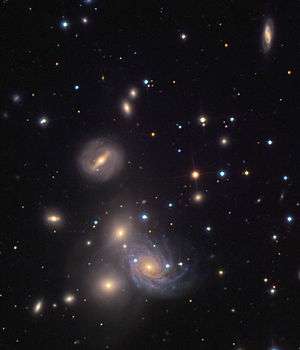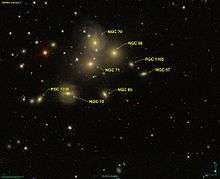NGC 68 group
| VV 166 | |
|---|---|
 | |
| Observation data (Epoch ) | |
| Constellation(s) | Andromeda |
| Right ascension | main group 00h 18m 30s cluster center 00h 18m 45s |
| Declination | main group 30° 03′ 00″ cluster center 30° 00′ 00″ |
| Number of galaxies |
40 (confirmed) 60+ (possible)[1] |
| Richness class | Group 0/1 |
| Bautz-Morgan classification | type II/III |
| Velocity dispersion | ~6750[1] |
| Redshift | 0.019 to 0.025 |
| Distance (co-moving) | ~300 mly |
| Other designations | |
| [M98j] 003, VV 166, RSCG 01, WBL 007, USCG U012, RASSCALS SRGb 062, PCC S34-115, HOLM 006, SRGb 062, DOC SRGb 062, WP 01, PPS2 060, HDCE 0011 | |
VV 166, sometimes also called the NGC 70 galaxy group or Arp 113, is a cluster of galaxies in Andromeda. The main group was discovered in 1784 by William Herschel, who listed the galaxies as a single object. Later, in the 1880s, John Louis Emil Dreyer managed to discern some of the galaxies in this region and cataloged them.[2] The prominent elliptical galaxy in the region, NGC 68, is probably not a member of the group.

The galaxy group with labels
Superimposed on the group is a smaller cluster around 220 mly away, which includes AGC 102760, UGC 152, and UGC 166.
Members
| galaxy | RA | DEC | redshift | size (ly) | distance (mly) |
|---|---|---|---|---|---|
| NGC 67 | 00h 18m 12.18s | 30° 03′ 17.5″ | 0.020734[1] | 40,000 | 275[3] |
| NGC 67a | 00h 18m 14.83s | 30° 03′ 45″ | 0.022162 | 35,000 | 300 |
| NGC 68 | 00h 18m 18.48s | 30° 04′ 15.4″ | 0.01913 | 90,000 | 260 |
| NGC 69 | 00h 18m 20.5s | 30° 02′ 21.2″ | 0.022285 | 80,000 | 300 |
| NGC 70 | 00h 18m 22.6s | 30° 04′ 44″ | 0.023907 | 180,000 | 320 |
| NGC 71 | 00h 18m 23.6s | 30° 03′ 45″ | 0.022339 | 130,000 | 300 |
| NGC 72 | 00h 18m 28.36s | 30° 02′ 23.7″ | 0.024213 | 120,000 | 325 |
| NGC 72a | 00h 18m 34.35s | 30° 02′ 08″ | 0.022399 | 25,000 | 300 |
| NGC 74 | 00h 18m 49.39s | 30° 03′ 39.1″ | 0.023646 | 65,000 | 315 |
| GALEXASC J001817.48+295854.3 | 00h 18m 17s | 29° 58′ 50″ | 0.024981 | 30,000[4] | 335 |
| PGC 1183 | 00h 18m 14.05s | 29° 57′ 05″ | 0.020374 | 70,000 | 275 |
| PGC 1163 | 00h 17m 46.02s | 30° 09′ 4.5″ | 0.021885 | 75,000 | 295 |
| 2MASX J00174636+2957409 | 00h 17m 46.3s | 29° 57′ 39″ | 0.024113 | 60,000 | 325 |
| 2MASX J00183652+2955586 | 00h 18m 36.5s | 29° 55′ 55.2″ | 0.021475 | 30,000 | 290 |
| 2MASX J00181971+2954372 | 00h 18m 19.67s | 29° 54′ 35″ | 0.022192 | 50,000 | 300 |
| 2MASX J00181589+2954145 | 00h 18m 15.92s | 29° 54′ 12.5″ | 0.024093 | 45,000 | 325 |
| 2MASX J00191196+3000506 | 00h 18m 11.97s | 30° 00′ 47.8″ | 0.023456 | 45,000 | 315 |
| 2MASX J00191966+3005286 | 00h 19m 19.64s | 30° 05′ 26″ | 0.02389 | 60,000 | 320 |
| 2MASX J00183355+2950272 | 00h 18m 31.52s | 29° 50′ 24.3″ | 0.020981 | 30,000 | 285 |
| 2MASX J00174173+2951151 | 00h 17m 41.71s | 29° 51′ 12.4″ | 0.022359 | 35,000 | 300 |
| PGC 1138 | 00h 17m 17.38s | 30° 12′ 30.5″ | 0.020988 | 55,000 | 285 |
| PGC 1119 | 00h 17m 02.63s | 29° 56′ 29.7″ | 0.023116 | 80,000 | 310 |
| NGC 76 | 00h 19m 37.81s | 29° 55′ 59.3″ | 0.02444 | 120,000 | 330 |
| AGC 102761 | 00h 19m 43.83s | 30° 03′ 25.5″ | 0.023590 | 10,000 | 320 |
| 2MASX J00164915+3010462 | 00h 16m 49.16s | 30° 10′ 43.5″ | 0.024133 | 40,000 | 325 |
| PGC 1266 | 00h 19m 43.06s | 29° 56′ 4.1″ | 0.022339 | 45,000 | 300 |
| 2MASX J00181849+2942002 | 00h 18m 18.47s | 29° 41′ 57.7″ | 0.022749 | 45,000 | 305 |
| 2MASX J00194032+2949286 | 00h 19m 40.35s | 29° 49′ 26.1″ | 0.025621 | 50,000 | 345 |
| PGC 1090 | 00h 16m 32.85s | 30° 20′ 42.5″ | 0.021331 | 85,000 | 290 |
| PGC 1220 | 00h 18m 55.28s | 30° 30′ 46.6″ | 0.02408 | 50,000 | 325 |
| 2MASX J00160018+3002561 | 00h 16m 00.31s | 30° 02′ 54.9″ | 0.022676 | 45,000 | 305 |
| AGC 100116 | 00h 15m 55.55s | 30° 04′ 25.2″ | 0.022379 | 35,000 | 305 |
| PGC 1084 | 00h 16m 24.93s | 30° 22′ 25.5″ | 0.021148 | 55,000 | 290 |
| 2MASX J00203207+3003013 | 00h 20m 32.06s | 30° 02′ 58.8″ | 0.021058 | 35,000 | 285 |
References
- 1 2 3 "objects within 30 arcminutes of NGC 72a". NED. NASA/IPAC. Retrieved 18 May 2014.
- ↑ Seligman, Courtney. "New General Catalog Objects: NGC 50 - NGC 99". Cseligman.com. Retrieved 18 May 2014.
- ↑ Wright, Ned. "Ned Wright's Javascript Cosmology Calculator". astro.ucla.edu. UCLA. Retrieved 18 May 2014.
- ↑ "Angular Size Calculator". www.1728.org. Retrieved 18 May 2014.
This article is issued from
Wikipedia.
The text is licensed under Creative Commons - Attribution - Sharealike.
Additional terms may apply for the media files.